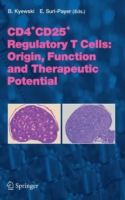The vertebrate immune system defends the organism against invading pathogens while at the same time being self-tolerant to the body's own constituentsthuspreservingitsintegrity. Multiplemechanismsactinconcert to ensure self-tolerance. During intrathymic development, the nascent T cell repertoire is purged from autoreactive T cells via negative selection, a process also known as recessive tolerance. Ridding of self-reactivity, however,isnotcomplete,asattestedbythepresenceofself-reactiveTcells intheperipheralTcellrepertoire. Hence,additionaltolerancemechanisms, collectively referred to as dominant tolerance, have been postulated on theoreticalgrounds(seethechapterbyA. Coutinhoetal. inthisvolume)and experimentalprooffortheirexistencehadbeenrepeatedlyclaimedinthepast 40years. Whilesomeoftheseclaims,largelybasedoninvitroexperiments, laterfellintodisrepute(i. e. ,theinfamousCD8suppressorcellsexpressingI-J molecules),concurrent,butlesswellpublicizedstringsofresearch,provided unremitting evidence for dominant tolerance mechanisms.
These include the postnatal thymectomy model pioneered by Nishizuka and Sakakura in 1969, the dominant tolerance model in chicken and quail chimeras introducedbyleDouarinandcolleagues,andstudiesoninfectioustolerance by the Waldmann laboratory. A breakthrough in this ?eld was achieved by the identi?cation and isolation by Sakaguchi's and Shevach's groups of + + aCD4 CD25 TcellsubsetexertingsuppressiononeffectorTcellsbothin vitroandinvivo. Thisinstigatedanavalancheofpublicationsonsuppressor Tcells. Whilelargelyoverlookedforsomanyyears,thereisnowhardlyany aspectofimmunitythatdoesnotseemtobeaffectedbysuppressorTcells. This volume will hardly be more than a snapshot in thisfast-moving ?eld, yetwehopethatitwillofferinspirationandorientationtothescientistwho wouldliketoenterthis?eld. To date, many different cells have been described that can suppress + + other cells of the immune system: CD4 CD25 regulatory T cells (Treg), + ? CD4 CD25 regulatory T cells, T regulatory 1 cells (Tr1), T-helper 3 cells + ? (Th3),CD8 CD28 Tcells,NKTcells,aswellastolerogenicdendriticcells. Suppressive CD4 T cells fall at least into two categories.
So called natural VI Preface + + CD4 CD25 Tregformpartoftheintra-thymicallyselectedTcellrepertoire andapparentlyconstituteadistinctlineage. Incontrast,"adaptive"regulatory Tcellsareinstructedintheperipherytobecomesuppressivecells,theyform + + amoreheterogeneousgroupincludingCD4 CD25 Treg,Tr1,andTh3cells. As natural Treg are so far the best characterized entity, the ?rst three contributionsofthisvolume(C. Cozzoetal. ,C. -S. Hsiehetal. ,andL.
EAN 9783540244448
ISBN 3540244441
Binding Hardback
Publisher Springer, Berlin
Publication date May 23, 2005
Pages 332
Language English
Dimensions 235 x 155
Country Germany
Readership Professional & Scholarly
Illustrations XII, 332 p. 18 illus., 12 illus. in color.
Editors Kyewski B.; Suri-Payer Elisabeth
Series Current Topics in Microbiology and Immunology

















